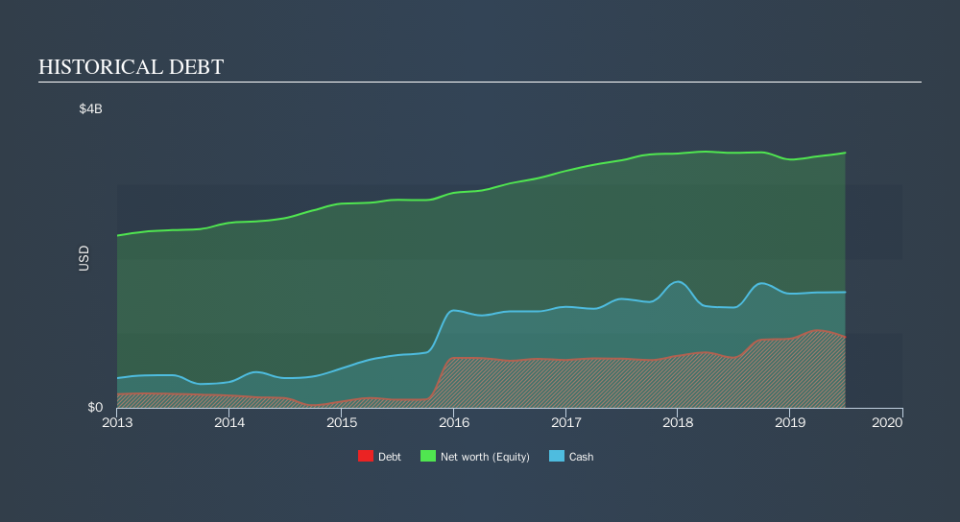We Think Seaboard (NYSEMKT:SEB) Can Stay On Top Of Its Debt

David Iben put it well when he said, 'Volatility is not a risk we care about. What we care about is avoiding the permanent loss of capital. So it seems the smart money knows that debt - which is usually involved in bankruptcies - is a very important factor, when you assess how risky a company is. We can see that Seaboard Corporation (NYSEMKT:SEB) does use debt in its business. But is this debt a concern to shareholders?
When Is Debt Dangerous?
Debt and other liabilities become risky for a business when it cannot easily fulfill those obligations, either with free cash flow or by raising capital at an attractive price. Ultimately, if the company can't fulfill its legal obligations to repay debt, shareholders could walk away with nothing. However, a more frequent (but still costly) occurrence is where a company must issue shares at bargain-basement prices, permanently diluting shareholders, just to shore up its balance sheet. Having said that, the most common situation is where a company manages its debt reasonably well - and to its own advantage. The first thing to do when considering how much debt a business uses is to look at its cash and debt together.
View our latest analysis for Seaboard
What Is Seaboard's Debt?
You can click the graphic below for the historical numbers, but it shows that as of June 2019 Seaboard had US$948.0m of debt, an increase on US$673.0m, over one year. But it also has US$1.55b in cash to offset that, meaning it has US$602.0m net cash.
A Look At Seaboard's Liabilities
Zooming in on the latest balance sheet data, we can see that Seaboard had liabilities of US$905.0m due within 12 months and liabilities of US$1.58b due beyond that. On the other hand, it had cash of US$1.55b and US$546.0m worth of receivables due within a year. So its liabilities total US$386.0m more than the combination of its cash and short-term receivables.
Of course, Seaboard has a market capitalization of US$4.84b, so these liabilities are probably manageable. But there are sufficient liabilities that we would certainly recommend shareholders continue to monitor the balance sheet, going forward. While it does have liabilities worth noting, Seaboard also has more cash than debt, so we're pretty confident it can manage its debt safely.
In fact Seaboard's saving grace is its low debt levels, because its EBIT has tanked 61% in the last twelve months. When it comes to paying off debt, falling earnings are no more useful than sugary sodas are for your health. When analysing debt levels, the balance sheet is the obvious place to start. But it is Seaboard's earnings that will influence how the balance sheet holds up in the future. So if you're keen to discover more about its earnings, it might be worth checking out this graph of its long term earnings trend.
But our final consideration is also important, because a company cannot pay debt with paper profits; it needs cold hard cash. Seaboard may have net cash on the balance sheet, but it is still interesting to look at how well the business converts its earnings before interest and tax (EBIT) to free cash flow, because that will influence both its need for, and its capacity to manage debt. In the last three years, Seaboard's free cash flow amounted to 26% of its EBIT, less than we'd expect. That's not great, when it comes to paying down debt.
Summing up
While it is always sensible to look at a company's total liabilities, it is very reassuring that Seaboard has US$602.0m in net cash. So we don't have any problem with Seaboard's use of debt. Over time, share prices tend to follow earnings per share, so if you're interested in Seaboard, you may well want to click here to check an interactive graph of its earnings per share history.
When all is said and done, sometimes its easier to focus on companies that don't even need debt. Readers can access a list of growth stocks with zero net debt 100% free, right now.
We aim to bring you long-term focused research analysis driven by fundamental data. Note that our analysis may not factor in the latest price-sensitive company announcements or qualitative material.
If you spot an error that warrants correction, please contact the editor at editorial-team@simplywallst.com. This article by Simply Wall St is general in nature. It does not constitute a recommendation to buy or sell any stock, and does not take account of your objectives, or your financial situation. Simply Wall St has no position in the stocks mentioned. Thank you for reading.

 Yahoo Finance
Yahoo Finance 
